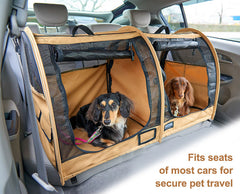Are you prepared for pet evacuation?

PREPARE your family's emergency kits and pet carriers well before you may need them.
ACT to introduce and familiarize each family member — including your pets — to the pet carriers and portable kennels, where they are stored, and the idea that the carriers are your animals' 'safe space'
CONTAIN your pets as quickly and calmly as you can once an emergency develops. Contain your pets first before searching your house for valuables so that your pets will be less fearful and likely to hide.
EVACUATE immediately upon securing your emergency supplies and pet carriers.
Start preparing now: Our travel-friendly Pop-Up Kennels with the included carrying case and Pet Carriers make a great foundation for your Pet Evacuation Kit.
Evacuation Kit Checklist:
- Food. Minimum three day supply in a waterproof container.
- Water. Again a three day supply of bottled water and a water bowl.
- Medicines and Vet records.
- Collar or harness with ID tag, rabies tag and a leash.
- Consider Microchipping: Talk to your veterinarian about microchipping and enrolling your pet in a recovery database. See list of common manufacturers below.
- Selfie with pets. Photos of you with your pet(s). And any unique identifying markings. Photos will help you document ownership and allow others to assist you if you and your pet become separated.
- First aid kit. Bandages, antibiotic ointment, flea and tick prevention, latex gloves, etc. Your first aid kit will do with the addition of flea and tick prevention.
- Kennel or pet carrier. Have a sturdy, safe kennel and/or carrier.
- Sanitation. Pet litter and litter box if appropriate, poo bags, plastic trash bags and household chlorine bleach.
- Familiar items. Toys, treats and bedding.
More on pet evacuation planning:
American Red Cross • ASPCA • FDA
The most common microchip brands:
|
Manufacturer |
Website |
| 24PetWatch | www.24petwatch.com |
| AKC | www.akcreunite.org |
| AVID | www.avidid.com |
| Banfield | www.banfield.net |
| Bayer resQ | www.petlink.net |
| HomeAgain | www.homeagain.com |



